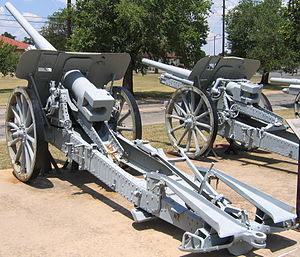10 cm K 17
| 10 cm Kanone 17 | |
|---|---|
 | |
| Type | Field gun |
| Place of origin | |
| Service history | |
| In service | 1917-1945 |
| Used by | |
| Wars | World War I World War II |
| Production history | |
| Designer | Krupp |
| Designed | 1916 |
| Manufacturer | Krupp |
| Produced | 1917-18 |
| No. built | 192 |
| Variants | 10 cm Kanone 17/04 |
| Specifications | |
| Mass | 3,300 kg (7,275 lbs) |
| Length | 4.725 m (15.5 ft) |
| Barrel length | 2.036 m (6.67 ft) L/45 |
| Shell | separate-loading, cased charge |
| Caliber | 105 mm (4.13 in) |
| Breech | horizontal sliding block |
| Recoil | hydro-pneumatic or hydro-spring variable recoil |
| Carriage | box trail |
| Elevation | -2° to +45° |
| Traverse | 6° |
| Muzzle velocity | 650 m/s (2,132 ft/s) |
| Maximum firing range | 16,500 m (18,045 yds) |
The 10 cm Kanone 17 (10 cm K 17) was a field gun used by Germany in World War I and World War II.
Development
The range of the 10 cm K 14 was deemed insufficient in combat and Krupp designed a new, longer (L/45) barrel that mounted on the K 14's carriage. This made the gun too heavy to be transported in a single load and the barrel had to be removed and stowed on its own transport wagon. The ramps visible in the picture served to guide the barrel transport wagon into position to align the barrel with the recoil system to allow it to be winched into battery. These are fixed in place on this example, but were generally removable.
The K 17 used either a hydro-pneumatic or hydro-spring recoil system, presumably depending on manufacturer.
Anti-aircraft role
Despite the recognition that the K 17 wouldn't have any anti-aircraft role, most of the heavy and expensive features added to the K 14 in a failed bid to equip it as an AA gun were retained. Presumably this was to hasten the switchover from production of the K 14 to the K 17. A simpler version of the K 17 was designed in 1917 that harkened back to the K 04 in many ways. The complex sighting system was dropped in favor in one based on the sights used on the 15 cm sFH 13, variable recoil was deleted and the gun couldn't be broken down for transport. This was called the K 17/04 and some thousand were ordered in August 1917.
Fate
Germany was forbidden these guns by the Versailles Treaty and was supposed to scrap or sell all existing weapons. Some were sold to Sweden and Romania after the war, but some were hidden and saw service in World War II, mainly in the coast defense role.
External links
- 10 cm K 17 on Landships
- K 17 on Lovett Artillery Collection
- Development of the 10 cm Kanone on Lovett Artillery Collection
- List and pictures of WW1 surviving 10cm K 17 guns
References
- Engelmann, Joachim and Scheibert, Horst. Deutsche Artillerie 1934-1945: Eine Dokumentation in Text, Skizzen und Bildern: Ausrüstung, Gliederung, Ausbildung, Führung, Einsatz. Limburg/Lahn, Germany: C. A. Starke, 1974
- Gander, Terry and Chamberlain, Peter. Weapons of the Third Reich: An Encyclopedic Survey of All Small Arms, Artillery and Special Weapons of the German Land Forces 1939-1945. New York: Doubleday, 1979 ISBN 0-385-15090-3
- Hogg, Ian V. German Artillery of World War Two. 2nd corrected edition. Mechanicsville, PA: Stackpole Books, 1997 ISBN 1-85367-480-X
- Jäger, Herbert. German Artillery of World War One. Ramsbury, Marlborough, Wiltshire: Crowood Press, 2001 ISBN 1-86126-403-8
-
10 cm K 17 in Niagara Falls, Ontario




